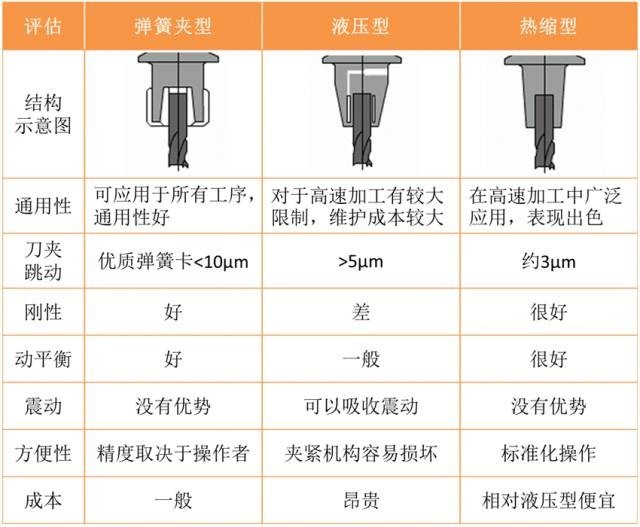Welcome to Pingyuan Huanyu Precision Machinery Co., LTD. Official website!
News
Types and uses of tool handles for machining centers
Release Time:
2018-02-08 09:32
Today I want to talk to you about the knowledge of machining center shank. Nowadays CNC machine tools are widely used in factories. These machine tools and tools come from all over the world, with different models and standards. Do you know what 7:24 means in the processing center BT shank? Do you know what BT, NT, JT, IT and CAT are?
The tool handle is the connecting body of the machine tool and the tool. The tool handle is a key link affecting the concentricity and dynamic balance. It must not be regarded as a general component. Concentricity can determine whether the cutting amount of each cutting edge part is uniform under the condition of one rotation of the tool; When the spindle rotates, the dynamic imbalance will produce periodic vibration.
1. It can be divided into two categories according to the spindle taper hole
According to the taper of machining center spindle tool hole is usually divided into two categories:
SK Universal shank with a taper of 7:24
HSK vacuum shank with taper 1:10
SK Universal shank with a taper of 7:24
7:24 refers to the shank taper of 7:24, for a separate cone orientation, the taper shank is longer. The cone surface plays two important roles at the same time, namely the accurate positioning of the shank relative to the spindle and the realization of the shank clamping.
Advantages: no self-locking, can realize fast loading and unloading tool; As long as the taper Angle is processed to high precision, the precision of the connection can be guaranteed, so the cost of the handle is relatively low.
Disadvantages: when rotating at high speed, the taper hole at the front end of the spindle will expand. The size of the expansion will increase with the increase of the rotation radius and speed, and the taper connection stiffness will decrease. Under the action of the pull rod, the axial displacement of the tool holder will also change. After each tool change, the radial size of the shank will be changed, and there is a problem of unstable positioning accuracy.
A general purpose shank with a 7:24 taper usually comes in five standards and specifications:
1. International Standard IS0 7388/1 (IV or IT)
2. Japan Standard MAS BT (BT for short)
3. German standard DIN 2080 (NT or ST for short)
4. American Standard ANSI/ASME (CAT)
5. DIN 69871 (JT, DIN, DAT or DV for short)
Tightening method:
The tool handle of NT type is pulled tight on the traditional machine tool by a pull rod, also known as ST in China; The other four kinds of handles are all pulled tight on the machining center through the pull nail at the end of the handle.
Universal:
1) At present, DIN 69871 (namely JT) and Japanese MAS BT are the most used tool handles in China;
2) The shank of DIN 69871 can also be mounted on ANSI/ASME spindle cone hole machine tools;
3) IS0 7388/1 shank can also be installed on DIN 69871, ANSI/ASME spindle cone hole machine tools, so in terms of versatility, IS0 7388/1 shank is the best.
HSK vacuum shank with taper 1:10
The HSK vacuum tool holder is deformed by the elasticity of the tool holder. Not only the 1:10 cone of the tool holder is in contact with the 1:10 cone of the main shaft hole of the machine tool, but also the flange plate surface of the tool holder is in close contact with the spindle surface. This double-sided contact system is superior to the universal tool holder in terms of high-speed machining, connection rigidity and coincidence accuracy.
HSK vacuum tool handle can improve the rigidity and stability of the system and product accuracy in high speed machining, and shorten the tool replacement time, plays an important role in high speed machining, it can adapt to the spindle speed of machine tool up to 60,000 RPM. HSK tool system is widely used in aerospace, automotive, precision mold and other manufacturing industries.
HSK handles are available in A, B, C, D, E, F, etc., among which, A, E and F are commonly used in machining centers (automatic tool changing).
The biggest differences between Type A and Type E:
1. Type A has a drive groove while type E does not. Therefore, relatively speaking, the transfer torque of type A is larger, and relatively can carry out some heavy cutting. The E model, on the other hand, delivers less torque and can only be used for light cutting.
2. In addition to the transmission groove, there are manual fixing holes and direction slots on the shank of type A, so the balance is relatively poor. And E type does not, so E type is more suitable for high-speed machining. The E and F mechanism is exactly the same, the difference is: the E and F handles of the same name (such as E63 and F63), the F shank cone is one size smaller. That is to say, the flange diameters of E63 and F63 are φ63, but the cone size of F63 is only the same as that of E50. Therefore, compared with E63, the speed of F63 will be faster (smaller spindle bearing).
2. The form of the tool holder
Spring chuck shank
Mainly used for drill, milling cutter, tap and other straight shank tool and tool clamping, circlip spring elastic deformation of 1mm, clamping range in diameter 0.5~32mm.
Hydraulic chuck
A- Locking screw, use the hex wrench to tighten the locking screw;
B- Lock the piston and press the hydraulic medium into the expansion chamber;
C- expansion chamber, pressure generated by liquid extrusion;
D- Thin expansion bushing, positioning tool clamping rod center and uniform envelope during locking.
E- Special seals ensure ideal seal and long service life.
Heating handle
Apply induction heating technology to heat the tool clamping part on the tool handle, so that its diameter will expand, and then put the cold tool rod into the hot tool handle. Heating tool handle clamping force, good dynamic balance, suitable for high-speed processing. High repetitive positioning accuracy, generally within 2μm, radial runout within 5μm; Good anti-fouling ability, good anti-interference ability in processing. However, each specification shank is only suitable for the installation of a handle diameter of the tool, need to be equipped with a set of heating equipment.
Heat shrinkable shank clamping principle:
Tool handle comprehensive evaluation and comparison: Today and you talk about the knowledge of processing center tool handle. Nowadays CNC machine tools are widely used in factories. These machine tools and tools come from all over the world, with different models and standards. Do you know what 7:24 means in the processing center BT shank? Do you know what BT, NT, JT, IT and CAT are?
The tool handle is the connecting body of the machine tool and the tool. The tool handle is a key link affecting the concentricity and dynamic balance. It must not be regarded as a general component. Concentricity can determine whether the cutting amount of each cutting edge part is uniform under the condition of one rotation of the tool; When the spindle rotates, the dynamic imbalance will produce periodic vibration.
1. It can be divided into two categories according to the spindle taper hole
According to the taper of machining center spindle tool hole is usually divided into two categories:
SK Universal shank with a taper of 7:24
HSK vacuum shank with taper 1:10
SK Universal shank with a taper of 7:24
7:24 refers to the shank taper of 7:24, for a separate cone orientation, the taper shank is longer. The cone surface plays two important roles at the same time, namely the accurate positioning of the shank relative to the spindle and the realization of the shank clamping.
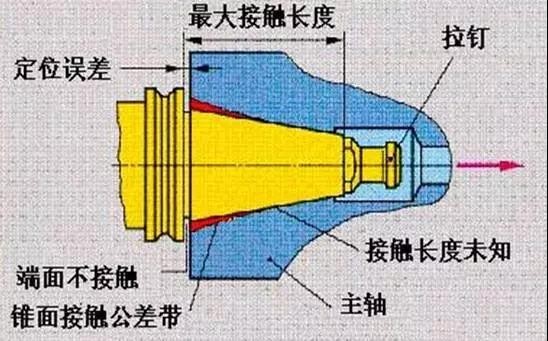
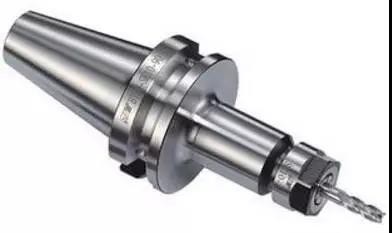
Advantages: no self-locking, can realize fast loading and unloading tool; As long as the taper Angle is processed to high precision, the precision of the connection can be guaranteed, so the cost of the handle is relatively low.
Disadvantages: when rotating at high speed, the taper hole at the front end of the spindle will expand. The size of the expansion will increase with the increase of the rotation radius and speed, and the taper connection stiffness will decrease. Under the action of the pull rod, the axial displacement of the tool holder will also change. After each tool change, the radial size of the shank will be changed, and there is a problem of unstable positioning accuracy.
A general purpose shank with a 7:24 taper usually comes in five standards and specifications:
1. International Standard IS0 7388/1 (IV or IT)
2. Japan Standard MAS BT (BT for short)
3. German standard DIN 2080 (NT or ST for short)
4. American Standard ANSI/ASME (CAT)
5. DIN 69871 (JT, DIN, DAT or DV for short)
Tightening method:
The tool handle of NT type is pulled tight on the traditional machine tool by a pull rod, also known as ST in China; The other four kinds of handles are all pulled tight on the machining center through the pull nail at the end of the handle.
Universal:
1) At present, DIN 69871 (namely JT) and Japanese MAS BT are the most used tool handles in China;
2) The shank of DIN 69871 can also be mounted on ANSI/ASME spindle cone hole machine tools;
3) IS0 7388/1 shank can also be installed on DIN 69871, ANSI/ASME spindle cone hole machine tools, so in terms of versatility, IS0 7388/1 shank is the best.
HSK vacuum shank with taper 1:10
The HSK vacuum tool holder is deformed by the elasticity of the tool holder. Not only the 1:10 cone of the tool holder is in contact with the 1:10 cone of the main shaft hole of the machine tool, but also the flange plate surface of the tool holder is in close contact with the spindle surface. This double-sided contact system is superior to the universal tool holder in terms of high-speed machining, connection rigidity and coincidence accuracy.
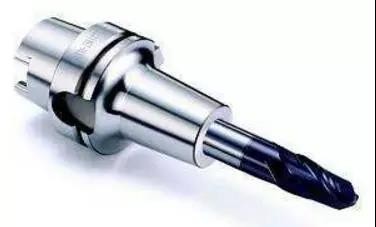
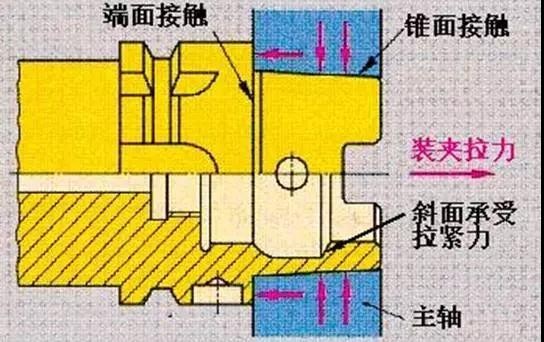
HSK vacuum tool handle can improve the rigidity and stability of the system and product accuracy in high speed machining, and shorten the tool replacement time, plays an important role in high speed machining, it can adapt to the spindle speed of machine tool up to 60,000 RPM. HSK tool system is widely used in aerospace, automotive, precision mold and other manufacturing industries.
HSK handles are available in A, B, C, D, E, F, etc., among which, A, E and F are commonly used in machining centers (automatic tool changing).
The biggest differences between Type A and Type E:
1. Type A has a drive groove while type E does not. Therefore, relatively speaking, the transfer torque of type A is larger, and relatively can carry out some heavy cutting. The E model, on the other hand, delivers less torque and can only be used for light cutting.
2. In addition to the transmission groove, there are manual fixing holes and direction slots on the shank of type A, so the balance is relatively poor. And E type does not, so E type is more suitable for high-speed machining. The E and F mechanism is exactly the same, the difference is: the E and F handles of the same name (such as E63 and F63), the F shank cone is one size smaller. That is to say, the flange diameters of E63 and F63 are φ63, but the cone size of F63 is only the same as that of E50. Therefore, compared with E63, the speed of F63 will be faster (smaller spindle bearing).
2. The form of the tool holder
Spring chuck shank
Mainly used for drill, milling cutter, tap and other straight shank tool and tool clamping, circlip spring elastic deformation of 1mm, clamping range in diameter 0.5~32mm.
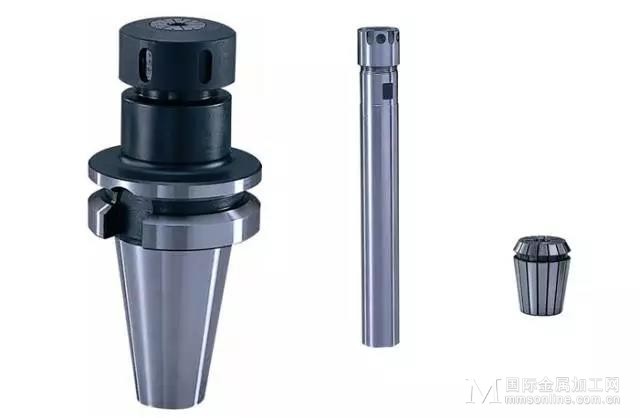
Hydraulic chuck
A- Locking screw, use the hex wrench to tighten the locking screw;
B- Lock the piston and press the hydraulic medium into the expansion chamber;
C- expansion chamber, pressure generated by liquid extrusion;
D- Thin expansion bushing, positioning tool clamping rod center and uniform envelope during locking.
E- Special seals ensure ideal seal and long service life.
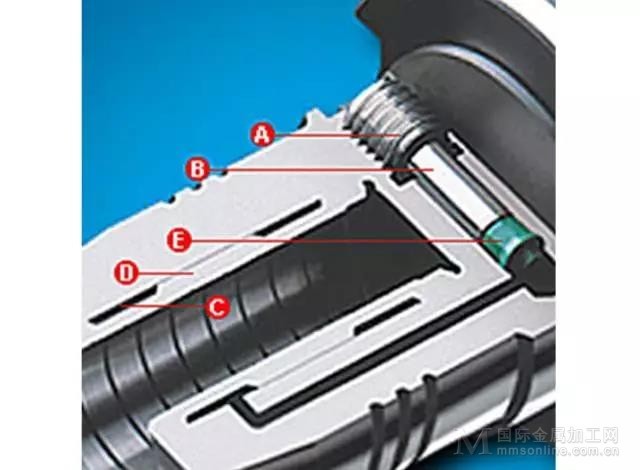
Heating handle
Apply induction heating technology to heat the tool clamping part on the tool handle, so that its diameter will expand, and then put the cold tool rod into the hot tool handle. Heating tool handle clamping force, good dynamic balance, suitable for high-speed processing. High repetitive positioning accuracy, generally within 2μm, radial runout within 5μm; Good anti-fouling ability, good anti-interference ability in processing. However, each specification shank is only suitable for the installation of a handle diameter of the tool, need to be equipped with a set of heating equipment.
Heat shrinkable shank clamping principle:
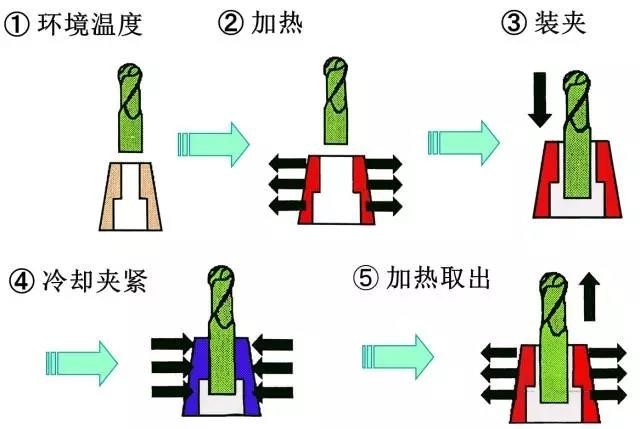
Comprehensive evaluation and comparison of tool handle:
